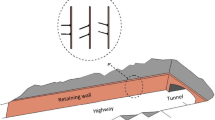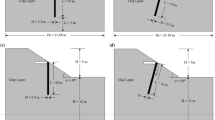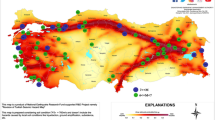Abstract
This paper conducts a series of centrifuge model tests to evaluate the seismic response characteristics of an anchor-pile-slope system. A real reinforced nonhomogeneous slope that remained stable during the 2008 Wenchuan earthquakes is utilized as the reference prototype. The recorded ground motion near the slope is selected as the seismic input. The responses in terms of slope acceleration and deformation, earth pressure, pile deformation and bending moment, and the anchor cable axial force are measured. The results have demonstrated that the slope vertical settlements and pile head displacements increase with increasing motion intensity. The maximum acceleration amplification is observed around the pile head, and the accelerations around the bedrock surface are attenuated. The largest dynamic earth pressure occurs at the pile head and then decreases with increasing depth due to the decreased soil-pile relative deformation. The presence of the anchor cable inhibits the build-up of dynamic earth pressure and leads to a negative bending moment. The maximum bending moment appears around the soil-rock interface because of the significant stiffness difference. Experimental results also illustrate that the axial force of the anchor cable is proportional to the pile head deformation. This work provides experimental evidence on the seismic behavior of a slope reinforced by anchored piles and will be beneficial to the calibration of numerical models and design methods.






















Similar content being viewed by others
Data Availability
The data that support the findings of this study are available on request from the corresponding author.
References
Al-Defae AH, Caucis K, Knappett JA (2013) Aftershocks and the whole-life seismic performance of granular slopes. Geotechnique 63(14):1230–1244
Arias A (1970) A measure of earthquake intensity. In: Hansen RJ (ed) Seismic design for nuclear power plants. MIT Press, Cambridge, pp 438–483
Bao YJ, Huang Y, Zhu CQ (2021) Effects of near-fault ground motions on dynamic response of slopes based on shaking table model tests. Soil Dyn Earthq Eng 149:106869
Bi J, Luo XQ, Zhang HT, Shen H (2019) Stability analysis of complex rock slopes reinforced with prestressed anchor cables and anti-shear cavities. Bull Eng Geol Env 78:2027–2039
Brennan AJ, Madabhushi SPG (2009) Amplification of seismic accelerations at slope crests. Can Geotech J 46:585–594
Cilingir U, Madabhushi SPG (2011) Effect of depth on seismic response of circular tunnels. Can Geotech J 48:117–127
GB/T 38509-2020 (2020) Code for the design of landslide stabilization. Industry Standard Compilation Group of the People's Republic of China, Beijing
Huang RQ, Li WL (2009) Analysis of the geo-hazards triggered by the 12 May 2008 Wenchuan Earthquake, China. Bull Eng Geol Env 68(3):363–371
Huang Y, Xu X, Mao W (2020a) Numerical performance assessment of slope reinforcement using a pile-anchor structure under seismic loading. Soil Dyn Earthq Eng 129:1–7
Huang Y, Xu X, Liu J, Mao W (2020b) Centrifuge modeling of seismic response and failure mode of a slope reinforced by a pile-anchor structure. Soil Dyn Earthq Eng 131:1–11
Huang Y, Zhu CQ (2016) Safety assessment of antiliquefaction performance of a constructed reservoir embankment. I: experimental assessment. J Performance Construct Facilities 31(2): 04016101
Huang MH, Fielding EJ, Liang CR, Milillo P, Salzer J (2017) Coseismic deformation and triggered landslides of the 2016 Mw 6.2 Amatrice earthquake in Italy. Geophys Res Lett 44(3):1266–1274
Kang GC, Song YS, Kim TH (2009) Behavior and stability of a large-scale cut slope considering reinforcement stages. Landslides 6(3):263–272
Kawashima K, Aydan Ö, Aoki T et al (2010) Reconnaissance investigation on the damage of the 2009 L’Aquila, central Italy earthquake. J Earthquake Eng 14(6):817–841
Keefer DK (1984) Landslides caused by earthquakes. Geol Soc Am Bull 95(4):406–421
Keefer DK (1994) The importance of earthquake-induced landslides to long-term slope erosion and slope-failure hazards in seismically active regions. Geomorphology 10(1):265–284
Liang T, Knappett JA, Duckett N (2015) Modelling the seismic performance of rooted slopes from individual root-soil interaction to global slope behaviour. Geotechnique 65(12):995–1009
Liu HS, Bo JS, Li P, Qi WH, Zhang YD (2016) Site amplification effects as an explanation for the intensity anomaly in the Hanyuan Town during the Wenchuan Mw 7.9 earthquake. Earthquake Eng Eng Vibration 15(3): 435–444
Pai LF, Wu HG (2021) Shaking table test of comparison and optimization of seismic performance of slope reinforcement with multi-anchor piles. Soil Dynam Earthquake Eng:106737
Qu HL, Luo H, Hu HG, Jia HY, Zhang DY (2018) Dynamic response of anchored sheet pile wall under ground motion: analytical model with experimental validation. Soil Dyn Earthq Eng 115:896–906
Sharma K, Deng L (2019) Reconnaissance report on geotechnical engineering aspect of the 2015 Gorkha, Nepal, earthquake. J Earthquake Eng 23(3):512–537
Shrestha S, Kang TS (2019) Assessment of seismically-induced landslide susceptibility after the 2015 Gorkha earthquake. Nepal Bull Eng Geol Environ 78:1829–1842
Siller TJ, Christiano PP, Bielak J (1991) Seismic response of tie-back retaining walls. Earthquake Eng Struct Dynam 20(7):605–620
Song YS, Hong WP, Woo KS (2012) Behavior and analysis of stabilizing piles installed in a cut slope during heavy rainfall. Eng Geol 129–130:56–67
Tang C, Zhu J, Qi X, Ding J (2011) Landslides induced by the Wenchuan earthquake and the subsequent strong rainfall event: a case study in the Beichuan area of China. Eng Geol 122(1–2):22–33
Tsai CC, Hsu SY, Wang KL, Yang HC, Chang WK, Chen CH, Hwang YW (2018) Geotechnical Reconnaissance of the 2016 ML 6.6 Meinong Earthquake in Taiwan. J Earthquake Eng 22:9: 1710–1736
Usluogullari OF, Temugan A, Duman ES (2016) Comparison of slope stabilization methods by three-dimensional finite element analysis. Nat Hazards 81(2):1027–1050
Wartman J, Dunham L, Tiwari B, Pradel D (2013) Landslides in Eastern Honshu Induced by the 2011 Tohoku Earthquake. Bull Seismol Soc Am 103(2B):1503–1521
Yang Z, Liu G, Wang LY, Liu SH, Fu XL (2021) Evolution of hydro-mechanical behaviours and its influence on slope stability for a post-earthquake landslide: implications for prolonged landslide activity. Bull Eng Geol Env 80:8803–8822
Ye S, Fang G, Zhu Y (2019) Model establishment and response analysis of slope reinforced by frame with prestressed anchors under seismic considering the prestress. Soil Dyn Earthq Eng 122:228–234
Yin YP, Wang FW, Sun P (2009) Landslide hazards triggered by the 2008 Wenchuan earthquake, Sichuan. China Landslides 6(2):139–152
Yin YP, Li B, Wang WP (2015) Dynamic analysis of the stabilized Wangjiayan landslide in the Wenchuan Ms 8.0 earthquake and aftershocks. Landslides 12(3):537–547
Zhang CL, Jiang GL, Su LJ, Lei D, Liu WM, Wang ZM (2020) Large-scale shaking table model test on seismic performance of bridge-pile-foundation slope with anti-sliding piles: a case study. Bull Eng Geol Env 79:1429–1447
Zhu CQ, Huang Y, Sun J (2020) Solid-like and liquid-like granular flows on inclined surfaces under vibration-Implications for earthquake-induced landslides. Comput Geotech 123:103598
Zhu CQ, Cheng HL, Bao YJ, Chen ZY, Huang Y (2022) Shaking table tests on the seismic response of slopes to near-fault ground motion. Geomech Eng 29(2):133–143
Funding
This work was supported by the Scientific Research Fund of the Institute of Engineering Mechanics, China Earthquake Administration (Grant No. 2020C02), the National Natural Science Foundation of China (Grant No. 51808515 and 41172293), the Joint Guiding Project of Natural Science Foundation of Heilongjiang Province (Grant No. LH2020E020), the Natural Science Foundation of Hebei Province (Grant No. E2020201017), and Hebei Provincial University Science and Technology Research Project (Grant No. ZD2020157).
Author information
Authors and Affiliations
Corresponding author
Rights and permissions
About this article
Cite this article
Zheng, T., Sun, Q., Liu, H. et al. Seismic performance of a nonhomogeneous slope reinforced by anchored piles using centrifuge tests. Bull Eng Geol Environ 83, 64 (2024). https://doi.org/10.1007/s10064-024-03559-3
Received:
Accepted:
Published:
DOI: https://doi.org/10.1007/s10064-024-03559-3




